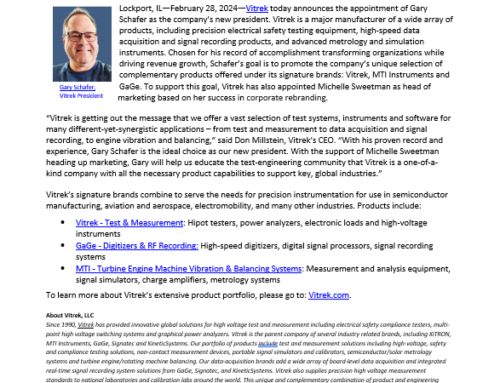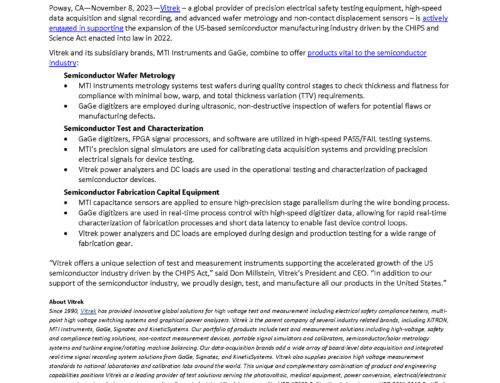GaGe Whitepaper: Real-Time High-Speed Data Acquisition on PC-Based System Platforms
By Gerald Allgaier, Systems Specialist and Bob Fitzgerald, Application Specialist – Vitrek
For many measurements that require the capture and processing of analog data, data throughput speed and conversion resolution are the two most important considerations. Typical examples include Radar, Signals Intelligence (SIGINT), Ultrasound Imaging, Non- Destructive Testing (NDT), Mass Spectroscopy / Time-of-Flight (TOF), and Production Test. These test applications usually demand high speed data transfer rates. So typically, Digitizers (A/D) or Arbitrary Waveform Generators (D/A) residing on a high-speed backplane are required. These applications many times require 2, 4 or more conversion channels, up to 16-bits of resolution, and real-time recording, processing/analysis, or playback.
Usually the conventional “box” type test equipment is fine for user interactive measurements. Or tests where measurements are relatively slow (less than 1000 readings/sec). But not well suited to cases where continuous real-time high-speed data flow (greater than 10 MS/s) to a host PC is required. This real-time requirement is easily met using measurement cards with a high-speed back-plane interface, as inside a PC.
With ever-increasing capabilities, current PC-based systems contin-ue to provide the highest performance, the best open and flexible architecture, and are the most cost-effective affordable platform for constructing real-time high-speed data acquisition systems.

PC-Based System Platform Advantages Versus Conventional Signal Test Equipment
Oscilloscopes
Most box type oscilloscopes are used by digital designers for R&D debug and development. As such, they are optimized for an interactive user interface, with large color displays and extensive front panel functionality. The typical 8-bit oscilloscope resolution is a good fit to view digital data on a linear amplitude display.
However, most models are limited in their memory capture depth. They are usually optimized for screen viewing speed, so have excellent specifications relating to screen update rate in “waveforms/sec”. But that performance tradeoff frequently means transfer rates are relatively slow to external computers. The measurement transfer rate is usually limited by the USB or Ethernet connection to the host platform. And data is typically transferred in non-continuous blocks. High end oscilloscopes can be very expensive, with long option lists that can quickly add up to thousands of dollars per unit.
In contrast, PC-based systems can support high-speed multi-channel PCI Express (PCIe) based digitizers. These solutions can provide the highest dynamic range data, very high-speed A/D sampling rates, with wide (> GHz) analog bandwidth. But most important – within a platform that supports high-speed storage systems, allowing for multiple terabytes of continuous signal data capture recording in real-time. In addition, embedded real-time digital signal processing capabilities can be added either via onboard FPGAs or GPU CUDA-based cards, and signal playback via added D/A generator cards. All within a Windows environment for ease of control and data handling.
Spectrum Analyzers
Most low-cost box type spectrum analyzers capture a large spectrum via swept tuning, or by capturing many consecutive frequency bands and piecing them together to form the larger spectrum image. One advantage of the swept tuned or narrowband capture method is the better spurious free dynamic range (SFDR) performance versus wider band capture systems. However, a significant disadvantage for many applications is that the frequencies on the display are captured at different moments in time.
For applications that require real-time capture of a large spectrum of interest, and need to record it continuously for analysis, most spectrum analyzers fall short. Like oscilloscopes, they are optimized for screen viewing, and most can provide only snapshots of data, rather than the desired real-time continuous wide bandwidth recordings.
In contrast, a PC-based system with integrated PCIe-based digitizers (A/D) can easily record wide bandwidths without losing any data. These solutions are ideal for baseband or IF signal data capture. The full wideband spectrum can be captured, displayed, and recorded to high-speed integrated storage continuously with no breaks in the signal data record for multiple hours of recording.
Signal Generators
Most boxed-based signal generators are useful for playing very simple and repetitive waveforms.
The complimentary PC-based system with integrated PCIe Arbitrary Waveform Generator (D/A) delivers the same advanced capabilities for creating unique waveforms. Many terabytes of data samples can be used for replaying analog data from previously digitized analog signals. This is particu-larly useful in testing a new system’s response to previously recorded real-world signals.
PC-Based System Platform Building Blocks
PCI Express (PCIe)

Figure 2. PCI Express (PCIe) Bidirectional Transfer Speeds in Gigabytes per Second (GB/s) for each Generation.
The key technology in enabling real-time high-speed data ac-quisition systems on PC-based system platforms is the Periph-eral Component Interconnect Express (PCIe) standard. PCIe is a high-speed serial based interface where each “lane” of a PCIe connection contains a transmit and receive pair of differential lines that form two serial channels capable of transporting data packets in both directions simultaneously between device link endpoints. Peak data throughput scales with multiple lanes as packet data is striped across them.
As shown in Figure 2, each generational implementation of the PCIe specification has doubled the maximum data transfer rate speed of the prior generation, while fully maintaining backward compatibility with all previous generations.

Figure 3. Building Blocks of Real-Time High-Speed Data Acquisition System with Integrated PCIe Instruments.
These very high-speed PCIe based interface connections thus allow for the creation of real-time data acquisition systems by integrating targeted PCIe based instruments as shown in Fig. 3.
To maximize the sustained data transfer rates of operating multiple devices simultaneously, careful attention should be noted regarding:
-
Architecture of Host System PCIe Interfaces
-
PCIe Gen Interface Type of Each Device
-
Max. Sustained Transfer Rate of Each Device
PC System Platform
On modern PC-based platforms, PCIe lanes are allocated from the system processors (CPUs) or from the system Platform Controller Hub (PCH) chipset to provide PCIe expansion slots for add-in card devices, add-in storage devices, or to facilitate onboard external device interfaces such as Thunderbolt, Ethernet, USB, audio, etc. as shown in Figure 4.
Ideally it is best to maximize PCIe resources that do NOT share data bandwidth with other devices on the system platform as represented in the green colored block items shown in Figure 4.
PCIe lanes allocated directly from the CPU(s) can supply dedicated PCIe slots that do not share data bandwidth between slots; hence providing maximum data transfer rate performance for multiple instrument cards operating simultaneously. Workstation/Server class CPUs typically provide more native PCIe lanes resources than Desktop class CPUs, thus providing for a higher number of dedicated PCIe slots and resources.
In contrast, Desktop class CPUs and platforms with a lower amount of dedicated PCIe resources will allocate PCIe slots and resources supplied via the system PCH and with added PCIe switches as represented in the red colored block items shown in Figure 4. Caution with these resources is warranted as all devices connected via the platform chipset shares data bandwidth to the CPU and with other onboard devices (Ethernet, USB, SATA, etc.) that may negatively effect the maximum data transfer rates.
PCIe switches may also be problematic in that PCIe resources that are behind a switch will typically auto default down to the lowest common PCIe device type. Therefore a generational mix of PCIe devices behind a switch can negatively impact data transfer rates. For example, if there is a PCIe Gen3 device and a PCIe Gen1 device installed together behind a PCIe switch, then the Gen3 device will auto-downgrade to a Gen1 rate to match the PCIe Gen 1 device due to their shared connection via the switch to the system platform. Switches can also be implemented such that if only 1 slot is populated it may run at up to maximum x16 rate, but if 2 slots are populated then each device may only run up to maximum x8 rate each and so forth.

Figure 4. Simplified PC Motherboard Block Diagram
High-speed storage devices have also transitioned to using PCIe interfaces bypassing the slower bottleneck data transfer rate limits of older traditional SATA and SAS based interfaces. PCIe based storage devices typically utilize up to x4 lanes per device with multiple units striped together in a RAID based configuration to enable very high-speed data transfer rates.
Just as with PCIe add-in cards, PCIe based storage devices for high-speed real-time operations are best maximized by utilizing PCIe lanes allocated directly from the CPU(s) to not share data bandwidth with other system devices.
However, more dedicated PCIe lanes allocated to storage units means less dedicated PCIe lanes allocated to add-in card instruments and vice-versa. So, applications requiring multiple operating PCIe add-in card instruments and large high-speed storage will therefore typically utilize 2 or more Workstation/Server class CPUs to provide more dedicated bandwidth PCIe lanes required.
When selecting a system platform for high-speed real-time operations, one should consider the targeted application requirements with the total number of PCIe instruments and the effective data transfer rates to be sustained for each device operating simultaneously to ensure that the system platform can provide sufficient PCIe resources to support it.
PCIe Instrument Devices
The functionality of traditional boxed-based test equipment can be supplied in PCIe based form factor card instruments for an integrated system solution. As shown previously in Figure 3:
-
PCIe Digitizers perform A/D signal capture similarly to boxed oscilloscopes.
-
PCIe FPGAs/GPUs or host CPUs provide digital signal processing for analysis similarly to boxed spectrum analyzers.
-
PCIe Arbitrary Waveform Generators perform D/A signal output/playback similarly to boxed signal generators.
Yet PCIe based instruments can transfer data at significantly faster sustained rates making them much more suitable for high-speed real-time applications as compared to boxed-based test equipment that are limited in data transfer rates to a host system by their external interconnection (typically via USB or Ethernet).
When selecting PCIe instrument devices, one should consider the following factors:
-
PCIe Streaming Support
-
PCIe Gen Interface Type
-
PCIe Maximum Sustained Transfer Rates



